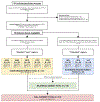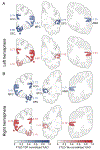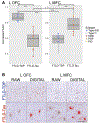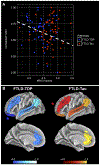Divergent patterns of TDP-43 and tau pathologies in primary progressive aphasia
- PMID: 30851133
- PMCID: PMC6538935
- DOI: 10.1002/ana.25465
Divergent patterns of TDP-43 and tau pathologies in primary progressive aphasia
Abstract
Objective: To measure postmortem burden of frontotemporal lobar degeneration (FTLD) with TDP-43 (FTLD-TDP) or tau (FTLD-Tau) proteinopathy across hemispheres in primary progressive aphasia (PPA) using digital histopathology and to identify clinicopathological correlates of these distinct proteinopathies.
Methods: In an autopsy cohort of PPA (FTLD-TDP = 13, FTLD-Tau = 14), we analyzed laterality and regional distribution of postmortem pathology, quantified using a validated digital histopathological approach, in available brain tissue from up to 8 cortical regions bilaterally. We related digital pathology to antemortem structural neuroimaging and specific clinical language features.
Results: Postmortem cortical pathology was left-lateralized in both FTLD-TDP (beta = -0.15, standard error [SE] = 0.05, p = 0.007) and FTLD-Tau (beta = -0.09, SE = 0.04, p = 0.015), but the degree of lateralization decreased with greater overall dementia severity before death (beta = -8.18, SE = 3.22, p = 0.015). Among 5 core pathology regions sampled, we found greatest pathology in left orbitofrontal cortex (OFC) in FTLD-TDP, which was greater than in FTLD-Tau (F = 47.07, df = 1,17, p < 0.001), and in left midfrontal cortex (MFC) in FTLD-Tau, which was greater than in FTLD-TDP (F = 19.34, df = 1,16, p < 0.001). Postmortem pathology was inversely associated with antemortem magnetic resonance imaging cortical thickness (beta = -0.04, SE = 0.01, p = 0.007) in regions matching autopsy sampling. Irrespective of PPA syndromic variant, single-word comprehension impairment was associated with greater left OFC pathology (t = -3.72, df = 10.72, p = 0.004) and nonfluent speech with greater left MFC pathology (t = -3.62, df = 12.00, p = 0.004) among the 5 core pathology regions.
Interpretation: In PPA, FTLD-TDP and FTLD-Tau have divergent anatomic distributions of left-lateralized postmortem pathology that relate to antemortem structural imaging and distinct language deficits. Although other brain regions may be implicated in neural networks supporting these complex language measures, our observations may eventually help to improve antemortem diagnosis of neuropathology in PPA. Ann Neurol 2019;85:630-643.
© 2019 American Neurological Association.
Conflict of interest statement
Potential Conflicts of Interest
Nothing to report.
Figures






Similar articles
-
Frontotemporal lobar degeneration proteinopathies have disparate microscopic patterns of white and grey matter pathology.Acta Neuropathol Commun. 2021 Feb 23;9(1):30. doi: 10.1186/s40478-021-01129-2. Acta Neuropathol Commun. 2021. PMID: 33622418 Free PMC article.
-
Prediction of pathology in primary progressive language and speech disorders.Neurology. 2010 Jan 5;74(1):42-9. doi: 10.1212/WNL.0b013e3181c7198e. Epub 2009 Nov 25. Neurology. 2010. PMID: 19940270
-
Typical and atypical pathology in primary progressive aphasia variants.Ann Neurol. 2017 Mar;81(3):430-443. doi: 10.1002/ana.24885. Epub 2017 Mar 20. Ann Neurol. 2017. PMID: 28133816 Free PMC article.
-
Primary progressive aphasia: defining genetic and pathological subtypes.Curr Alzheimer Res. 2011 May;8(3):266-72. doi: 10.2174/156720511795563728. Curr Alzheimer Res. 2011. PMID: 21222598 Review.
-
[Progressive nonfluent aphasia].Brain Nerve. 2011 Oct;63(10):1037-46. Brain Nerve. 2011. PMID: 21987561 Review. Japanese.
Cited by
-
Neuropathological fingerprints of survival, atrophy and language in primary progressive aphasia.Brain. 2022 Jun 30;145(6):2133-2148. doi: 10.1093/brain/awab410. Brain. 2022. PMID: 35441216 Free PMC article.
-
Reliability and modeling of digital histological measurements in Alzheimer's disease neuropathologic change and Lewy body disease.J Neuropathol Exp Neurol. 2025 Aug 1;84(8):725-733. doi: 10.1093/jnen/nlaf047. J Neuropathol Exp Neurol. 2025. PMID: 40272949 Free PMC article.
-
Frontotemporal lobar degeneration proteinopathies have disparate microscopic patterns of white and grey matter pathology.Acta Neuropathol Commun. 2021 Feb 23;9(1):30. doi: 10.1186/s40478-021-01129-2. Acta Neuropathol Commun. 2021. PMID: 33622418 Free PMC article.
-
Signature laminar distributions of pathology in frontotemporal lobar degeneration.Acta Neuropathol. 2022 Mar;143(3):363-382. doi: 10.1007/s00401-021-02402-3. Epub 2022 Jan 8. Acta Neuropathol. 2022. PMID: 34997851 Free PMC article.
-
Multimodal in vivo and postmortem assessments of tau in Lewy body disorders.Neurobiol Aging. 2020 Dec;96:137-147. doi: 10.1016/j.neurobiolaging.2020.08.003. Epub 2020 Aug 21. Neurobiol Aging. 2020. PMID: 33002767 Free PMC article.
References
-
- Mesulam MM. Primary progressive aphasia. Ann. Neurol 2001;49(4):425–432. - PubMed
Publication types
MeSH terms
Substances
Grants and funding
LinkOut - more resources
Full Text Sources
Miscellaneous

